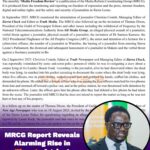Johannesburg, South Africa — With debt repayments consuming an ever-larger share of government revenues, African Ministers of Finance have formally adopted the African Debt Monitoring Mechanism (ADMM), a continent-wide platform designed to track and manage domestic and external debt in real time. The announcement came at the close of the African Union’s 8th Ordinary Session of the Specialised Technical Committee (STC) on Finance, held from 29 September to 3 October 2025.
The move follows alarming fiscal trends: nine African countries are currently in debt distress, while 11 others are at high risk, according to AFRODAD (African Forum and Network on Debt and Development). The median debt service across the continent is projected to rise to 29.2% of general government revenue in 2025, up from previous years. In 2023 alone, African countries paid an estimated $85 billion in debt service, the highest figure since 1998, diverting funds from critical sectors like health, education, and infrastructure.
AFRODAD, which has championed the ADMM since 2022, hailed the adoption as a “major milestone” in Africa’s debt reform agenda. Executive Director Jason Rosario Braganza emphasized that the mechanism aligns with Agenda 2063 and the Abuja Treaty, and will help challenge biased credit ratings from global agencies while reinforcing Africa’s financial sovereignty.
“Almost half the continent, 25 member states, are spending more on debt interest than on health,” Braganza noted, citing UNCTAD data. “This undermines our demographic dividend and exposes our dangerous dependency on external health financing.”
The ADMM will serve as a virtual debt surveillance hub within the African Union Commission, consolidating African-centric debt data and enhancing transparency across all stages of debt management, from strategy and contraction to analysis and dissemination. It will also support periodic assessments of member states’ debt practices, anchored in national legal frameworks.
The mechanism complements broader efforts to build the African Financial Architecture, including the African Monetary Fund (AMF), African Monetary Institute (AMI), AfCFTA, and the Africa Credit Rating Agency. It is also expected to reinforce the Borrowers Club initiative led by Zambia and Egypt, and the Common African Position on Debt adopted at the Pan-African Conference in Lomé.
The debt-health nexus was a central theme at the STC, held under the banner “Bridging Africa’s Health Financing Gap in a Changing Geo-Economic Context.” Despite the Abuja Declaration’s pledge to allocate 15% of national budgets to health, African governments spent just 7.4% on average in 2021, with 95% of Africans living in countries that failed to meet the target.
AU Commissioner H.E. Francisca Tatchouop Belobe called for stronger coordination between Ministries of Finance and Health, warning that rising medicine costs and stagnant budgets are eroding service delivery. The ADMM, she said, will be instrumental in aligning fiscal and health priorities to build resilient, equitable systems.
As debt pressures mount and fiscal space narrows, AFRODAD’s rallying call, “Africa: Rule Maker, Not Rule Taker”, resonates louder than ever. The ADMM offers a strategic tool to reclaim control over debt narratives, improve creditworthiness, and redirect resources toward sustainable development.









